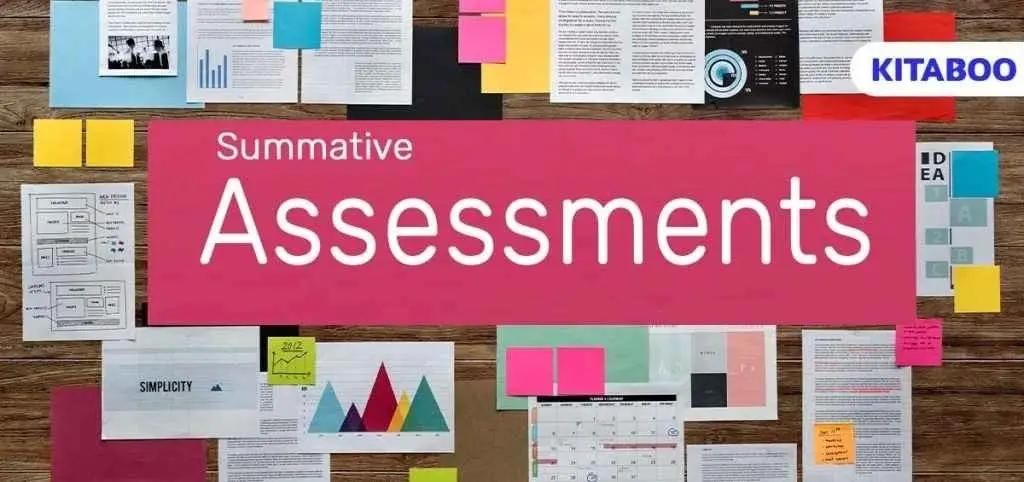
What are Summative Assessments? Feature, Advantages and Disadvantages
Summarize this blog with your favorite AI:
Do you think we can take ownership of our education and learning journey without the pressure of assessments? The majority of us have spent sleepless nights trying to prepare for a crucial assessment the next day.
Modern educational systems rely heavily on comprehensive student performance measurement to gauge learning effectiveness. Understanding different types of student evaluations helps educators create balanced frameworks that support both academic achievement and personal growth.
Anxiety, nervousness, restlessness, and lack of confidence are common phenomena before appearing for exams, but they often work as a constructive force to enhance our learning, performance, and growth.
Furthermore, assessments promote a deeper sense of learning in the student and allow teachers to evaluate the student’s learning needs, strengths, areas of improvement, and overall growth. Additionally, assessments also help teachers and educators identify the efficiency of their teaching methods and whether they align with the student’s learning goals.
The implementation of effective assessment techniques in education creates a comprehensive framework for measuring academic progress while identifying areas requiring additional support or enrichment strategies.
Summative assessments are one such assessment technique that allows instructors to measure student learning. You are in the right place if you are an educator, teacher, curriculum designer, or student wanting to know more about summative assessments.
In this comprehensively curated guide, we will begin with some basics and continue to explore the concept of summative assessments deeply.
Table of Contents
- What Are Assessments?
- What Are Summative Assessments?
- Types of Summative Assessment
- Summative vs Formative Assessment: Comprehensive Analysis
- Difference between Summative Assessments and Diagnostic Assessments
- Benefits of Summative Assessments
- Drawbacks of Summative Assessments
- Assessment Best Practices: Recommendations for Summative Assessments
- How Technology Enhances Summative Assessments
- Wrapping Up
What Are Assessments?
Assessments can be understood as evaluative processes or tools used to measure the learning, growth, and systematic development of learners.
Modern assessment best practices emphasize the importance of using multiple evaluation methods to create a holistic view of student achievement and learning outcomes.
Assessments are employed in a variety of educational and professional settings to conduct thorough evaluations and enhance an individual’s improvement. There are six major types of assessment. They are:
- Formative Assessments
- Summative Assessments
- Diagnostic Assessments
- Norm-Referenced Assessments
- Criterion-Referenced Assessments
- Benchmark Assessments
Each type serves distinct purposes in the educational process, contributing to comprehensive student performance measurement strategies that support both immediate learning needs and long-term educational goals.
What Are Summative Assessments?
Summative assessments are conducted at the end of a learning module or training program to assess the student’s proficiency, skills, knowledge, and growth. These assessments are strategically designed to evaluate both the learning of the students as well as the effectiveness of the program.
These comprehensive evaluations serve as crucial checkpoints in the educational journey, providing quantifiable data about student achievement levels. Unlike ongoing formative evaluations, summative assessments offer definitive snapshots of learning at specific intervals.
The result of the student’s performance is evaluated against a standard or pre-defined benchmark to ensure the learners have successfully met the learning objectives.
Effective summative assessment implementation requires careful alignment with curriculum standards, clear grading criteria, and strategic timing to maximize both student preparation and accurate measurement of learning outcomes.
Types of Summative Assessment
The summative assessment can be implemented through a variety of ways and techniques. Educators are now incorporating creative and engaging techniques in assessments offered by online platforms like KITABOO to keep the students positively engaged.
Traditional Summative Assessment Examples
Some of the common forms of summative assessment are:
- Objective/subjective question written examination
- Individual or group project
- Viva/interview or other oral tests
- Creative portfolio
- Presentations
- Essay or paper submissions
Advanced Digital Assessment Formats
Contemporary types of student evaluations have expanded to include innovative digital formats that better engage students while maintaining rigorous evaluation standards.
Academic Subject Examples:
- Final examinations: Comprehensive tests covering entire course content
- Research papers: In-depth analysis demonstrating critical thinking skills
- Capstone projects: Multidisciplinary projects showcasing accumulated knowledge
- Thesis presentations: Graduate-level research defense sessions
Performance-Based Assessments:
- Laboratory practicals: Hands-on skill demonstration in science subjects
- Artistic portfolios: Creative works showcasing artistic development over time
- Mock trials: Law students demonstrating legal reasoning and advocacy skills
- Clinical rotations: Medical students applying theoretical knowledge in real settings
Professional Certification Examples:
- Board examinations: Medical licensing exams like USMLE or PLAB
- Bar examinations: Legal profession entry requirements
- Teaching certification tests: PRAXIS exams for educator licensing
- Professional competency assessments: Industry-specific skill validations
Summative vs Formative Assessment: Comprehensive Analysis
Formative and summative assessments allow educators and teachers to identify the learning outcomes and potential of the students. However, the formative assessment is designed to focus on the learning gaps of the students and how the gaps can be closed.
On the other hand, summative assessments focus on overall learning and proficiency.
Real-World Implementation Examples
Formative Assessment in Action:
A high school biology teacher uses daily exit tickets asking students to identify one concept they understood and one they found confusing. This immediate feedback helps adjust the next day’s lesson plan.
Summative Assessment in Practice:
The same biology teacher administers a comprehensive end-of-semester exam covering all units, lab practicals, and a research project presentation to evaluate overall student mastery.
Consequently, unlike summative assessments, formative assessments do not require a systematic and predetermined evaluation tool and technique. A simple conversation with the learners can be made into a formative assessment, which allows the instructor to identify a student’s problems, misconceptions, weaknesses, and more.
Summative assessments are formally graded, and the learners receive the final score. This allows them to self-analyze their strengths and weaknesses and address them accordingly. Summative assessments are usually employed at the end of a learning module, whereas formative assessments are continual and ongoing.
Detailed Comparison Table
| Aspect | Formative Assessment | Summative Assessment |
|---|---|---|
| Primary Purpose | Monitor ongoing learning progress | Evaluate final learning outcomes |
| Timing | Throughout the learning process | At predetermined intervals (end of unit/course) |
| Feedback Type | Immediate, detailed, actionable | Comprehensive, evaluative, final |
| Grading Impact | Low stakes or ungraded | High stakes, significant grade weight |
| Student Response | Adjust learning strategies | Demonstrate mastery level |
| Teacher Action | Modify instruction methods | Evaluate program effectiveness |
| Examples | Exit tickets, peer discussions, quick polls | Final exams, major projects, standardized tests |
| Frequency | Daily or weekly | End of semester, quarterly |
Difference between Summative Assessments and Diagnostic Assessments
There is one major difference between summative assessment and diagnostic assessment. The summative assessment is performed at the end of the learning module, whereas the diagnostic assessment is performed before starting a learning module.
This timing difference serves distinct educational purposes within the complete assessment cycle.
Diagnostic assessment allows teachers and instructors to identify the learning gaps and help them determine their teaching steps accordingly.
Diagnostic assessments provide baseline data about student knowledge and skills before instruction begins. For instance, a mathematics teacher might administer a pre-algebra assessment to determine students’ readiness for advanced concepts.
Diagnostic assessments are not very comprehensive and are simply designed to provide the teachers with an overview of students’ learning capabilities and existing gaps. Some of the common forms of diagnostic assessment are oral interviews, pop quizzes, anecdotal records, questionnaires, surveys, problem-solving tasks, etc.
The strategic use of all three assessment types creates a comprehensive evaluation system that supports student learning throughout the entire educational process.
Benefits of Summative Assessments
Some of the key advantages of summative assessments are:
Academic Achievement Benefits
– A clear and effective measurement of learning outcomes
– Promotes accountability both for students and teachers
– Allows teachers to make data-driven and informed decisions
– Fosters a holistic and comprehensive learning environment
Real-World Impact Examples
Modern summative assessments provide concrete evidence of student achievement through standardized metrics. For example, Advanced Placement (AP) examinations enable high school students to demonstrate college-level mastery, potentially earning college credits and saving thousands in tuition costs.
Medical school licensing examinations like the USMLE ensure that future doctors possess essential competencies before treating patients. A 2023 study showed that students who passed these rigorous summative assessments had 89% higher success rates in clinical practice.
Personal Development Benefits
– Inculcates a sense of accomplishment in students
– Motivates students to promote self-growth and learning
– Prepare students for real-world situations and challenges
Students often report increased confidence after successfully completing challenging summative assessments. Sarah Chen, a Stanford graduate, credits her thesis defense experience with developing the presentation skills that helped her secure her dream job at a Fortune 500 company.
Institutional and System-Wide Benefits
– Generates systemized feedback for improvement and adjustments
– Promotes teachers to maintain consistent educational quality and standards
– Enhances student retention through focused revisions and reviews
Educational institutions use summative assessment data to evaluate program effectiveness. The University of Michigan’s Engineering Department analyzed five years of capstone project results, leading to curriculum improvements that increased student job placement rates by 34%.
Professional certification programs demonstrate how summative assessments drive continuous skill development. Microsoft’s certification exams motivate IT professionals to stay current with evolving technologies, with certified professionals earning an average of $15,000 more annually than non-certified peers.
Drawbacks of Summative Assessments
Along with the various advantages of summative assessments, there are also some drawbacks that should not be ignored. A thorough understanding of the drawbacks can allow educators to eliminate them and modify their teaching approach accordingly.
Psychological and Educational Challenges
Some of the major drawbacks of summative assessments are:
– Places students and learners in a high-pressure environment
– Lack of personalized learning pace and environment
– Encourages students to score marks and neglect in-depth learning
– Rely on a singular performance, disregarding gradual growth over time
– Leads students and learners to take up test anxiety
– Limited and narrow range of assessment methods
Systemic Issues and Solutions
High-stakes testing environments can create significant stress, particularly for students from disadvantaged backgrounds. Research indicates that test anxiety can reduce performance by up to 20%, regardless of actual knowledge levels.
The phenomenon of “teaching to the test” can narrow curriculum focus. However, innovative platforms like KITABOO help educators create engaging, comprehensive assessments that evaluate critical thinking rather than mere memorization.
Time constraints in traditional summative assessments may disadvantage students who process information thoroughly but slowly. Digital assessment platforms now offer flexible timing options while maintaining assessment integrity.
Assessment Best Practices: Recommendations for Summative Assessments
Teachers need to strike the right balance between motivating students and instructing students to achieve their learning goals.
Summative assessments should not pressure students but rather foster a positive learning environment.
Creating Effective Assessment Environments
Here are some recommendations teachers and instructions can keep in mind while conducting summative assessments and teaching students.
– Foster a positive competitive spirit in the students rather than the sole focus on scoring good marks.
– Incorporate interactive learning features offered by platforms like KITABOO to keep students motivated.
– Provide students ample time to prepare for the assessment with a clear and open mind.
Advanced Assessment Design Principles
– Provide clear and concise instructions to students on how to attempt the summative assessment.
– Incorporate real-world concepts in the assessment to bridge the gap between theoretical and practical understanding.
– Follow clear rubrics while marking and grading the students.
– Avoid ambiguous and tricky questions that can lead to misinterpretation.
Modern assessment techniques in education emphasize authentic performance tasks that mirror real-world applications. For example, business students might analyze actual case studies rather than hypothetical scenarios, while engineering students solve problems using current industry data.
Implementing universal design principles ensures assessments are accessible to all students while maintaining academic rigor. This includes providing multiple question formats, clear visual layouts, and assistive technology compatibility.
For comprehensive guidance on creating engaging evaluations, explore our insights on Innovative Assessment Methods for Modern Classrooms.
How Technology Enhances Summative Assessments
Modern educational technology has revolutionized how summative assessments are designed, delivered, and evaluated, creating more efficient and effective measurement tools.
Digital Platform Advantages
Contemporary student performance measurement leverages sophisticated platforms that provide immediate feedback and detailed analytics. KITABOO’s assessment platform exemplifies how technology transforms traditional evaluation methods.
Automated Grading Systems:
- Instant results for multiple-choice and short-answer questions
- Consistent scoring eliminating human bias
- Detailed performance analytics for educators
- Time savings allowing teachers to focus on instruction
Interactive Multimedia Assessments:
- Video-based questions testing practical application
- Audio components for language learning evaluation
- Interactive simulations for science and engineering subjects
- Rich media content increasing student engagement
Advanced Assessment Technologies
Artificial Intelligence Integration:
- Automated essay scoring with natural language processing
- Plagiarism detection ensuring academic integrity
- Personalized question banks adapting to student performance levels
- Predictive analytics identifying at-risk students
Adaptive Testing Systems:
- Questions adjust difficulty based on student responses
- Precise measurement of ability levels
- Reduced test anxiety through appropriate challenge levels
- Shorter assessment times while maintaining accuracy
Security and Accessibility Features:
- Blockchain technology for tamper-proof credentialing
- Biometric authentication preventing cheating
- Screen reader compatibility for visually impaired students
- Multi-language support for diverse learners
Real-World Implementation Success
Educational institutions worldwide report significant improvements with technology-enhanced summative assessments. The University of Barcelona increased assessment efficiency by 67% while improving student satisfaction scores after implementing digital assessment platforms.
Professional certification bodies like CompTIA and Cisco utilize adaptive online testing, enabling candidates to demonstrate competency more accurately while reducing examination time by an average of 40%.
Wrapping Up
It is safe to say that summative assessments can prove to be highly beneficial in a student’s learning journey if implemented effectively and efficiently. However, with time, it is also important to further develop the summative assessment standards by introducing new technologies and techniques.
The evolution of assessment methodologies continues to align with changing educational needs and technological capabilities. Modern types of student evaluations must balance traditional rigor with innovative approaches that engage diverse learners effectively.
In the current digital landscape, there are numerous tools, like machine learning, artificial intelligence, virtual reality, etc., to make summative assessments more creative and comprehensive.
For educators seeking to implement cutting-edge evaluation methods, the integration of technology with pedagogical best practices creates powerful assessment tools that support both learning and teaching effectiveness.
If you need help with the same, you can reach out to us at KITABOO. We are known globally for catering to customers’ digital educational needs. You can benefit from all our assessment services and greatly enhance your students’ learning experience.
Contact our expert team now and get started!
To know more, please write to us at contact@kitaboo.com
FAQs
Common summative assessment examples include final examinations, standardized tests, thesis defenses, capstone projects, comprehensive portfolios, and professional licensing exams. In K-12 education, examples include end-of-year state assessments, final course exams, and graduation requirements. Higher education uses comprehensive exams, dissertation defenses, and board certifications. Professional fields employ licensing examinations like medical boards, bar exams, and teaching certifications.
Summative assessments significantly impact student learning by providing clear learning targets, motivating sustained effort, and offering concrete feedback about achievement levels. They help students identify knowledge gaps and develop effective study strategies. Research shows that well-designed summative assessments can improve retention rates by up to 40% and increase long-term knowledge retention. However, overemphasis on high-stakes testing may encourage surface learning rather than deep conceptual understanding.
Yes, summative assessments can be effectively conducted online using secure digital platforms that maintain academic integrity. Modern online assessment systems offer features like browser lockdown, identity verification, automated proctoring, and advanced analytics. KITABOO's platform provides comprehensive online assessment capabilities including multimedia integration, adaptive questioning, and real-time monitoring. Digital summative assessments offer advantages including immediate results, enhanced accessibility, and detailed performance analytics while ensuring security and preventing cheating.
Discover how a mobile-first training platform can help your organization.
KITABOO is a cloud-based platform to create, deliver & track mobile-first interactive training content.



